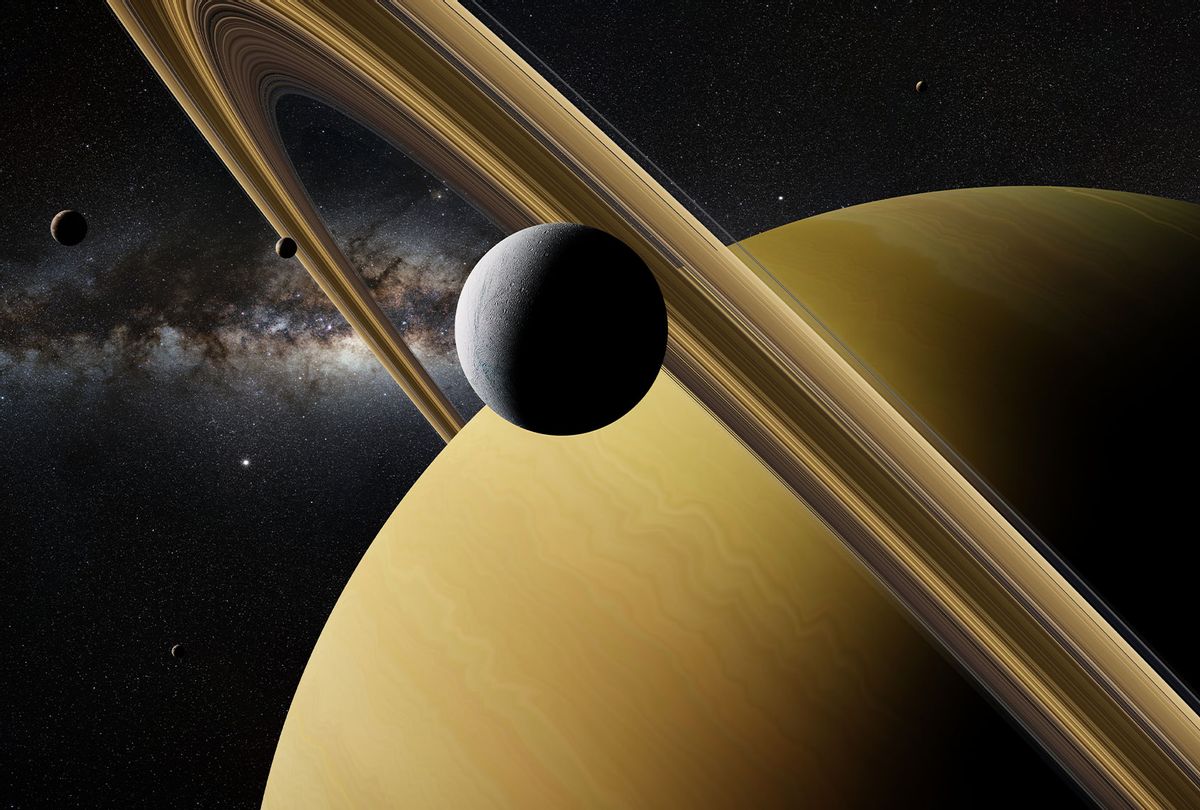When scientists using NASA's Cassini space probe discovered organic compounds in blocks of ice from Enceladus, they wondered if this meant the Saturnian moon might have the ingredients for life. Six years later, researchers working at research laboratories in Germany recreated conditions analogous to those on that distant frozen world. In the process, they obtained a tantalizing clue on how explorers can determine if Enceladus harbors extraterrestrials.
Previous experiments never studied the organic compounds from Enceladus in hydrothermal conditions such as those believed to exist on the moon's its subsurface ocean.
The scholars drew up new guidelines for understanding biosignatures from life-sustaining elements in future Enceladus missions, publishing their findings in the journal Philosophical Transactions of the Royal Society A: Mathematical, Physical and Engineering Sciences. They did so by analyzing data from the Cassini mission and using it to create on Earth a simulated version of the hydrothermal fields at the bottom of Enceladus' ocean.
Previous experiments never studied the organic compounds from Enceladus in hydrothermal conditions such as those believed to exist on the moon's its subsurface ocean, says the study's lead author Nozair Khawaja, a professor at Freie Universität Berlin's Department of Planetary Science and Remote Sensing. This recent study therefore broke new ground.
"Now the question that we followed was whether we can identify such biosignatures, which are processed under those extreme conditions, and whether we can differentiate those processed compounds from un-processed," said Khawaja. "Our findings show that hydrothermal processing do have effect on the appearance of those compounds" in their scientific equipment, meaning that biosignatures can be identified in future data coming from Enceladus."
Determining whether these biosignatures appeared in the conditions of hydrothermal vents was only one part of the challenge. The next part: Because some scientists suspect life on Earth may have begun in similar hydrothermal vents in our oceans, they wanted to see if outright organic molecules discovered in those fields might have formed more sophisticated molecules. Could they have even created amino acids, which are the basic building blocks of proteins and all life as we know it?
Want more health and science stories in your inbox? Subscribe to Salon's weekly newsletter Lab Notes.
"We will expand our simulations to incorporate more conditions to see their effect on the features of biosignatures in the data."
When the researchers built their hydrothermal chemical reactor, built from a stainless steel cylinder that can "simulate pressures found deeper within the porous core of Enceladus," as the paper notes, they found the answer was yes: When temperatures in the simulation reached between 80º to 150º C, and a pressure of 80 to 100 bar prevailed, the amino acids changed in ways characteristic of Earth-bound life forms.
At the same time, the pressure conditions were roughly a hundred times higher than on the Earth's surface. Even though the study demonstrated organic compounds could form amino acids on Enceladus, there are many other hurdles any potential life form would have to overcome to actually develop in that alien environment. Fortunately, Khawaja and the other researchers believe that these experiments can be performed given the right conditions.
"With this new laboratory setup, we will simulate a range of hydrothermal conditions, from the high pressures and temperatures associated with greater depths into the core, to the milder conditions in the ocean water near the water-rock interface," the authors write in the paper. "Investigations into the abundances and solubilities of inorganic (e.g. metal- or phosphorus-bearing) ions in the presence of organic matter using our hydrothermal reactor would offer insight into the detection of important biologically relevant molecules and complexes in ice grains from Enceladus."
Even the most sophisticated laboratory simulations, of course, cannot replicate the literal physical act of exploration. Astrobiologists dream of being able to directly study Enceladus and other potentially life-bearing worlds like it. It goes without saying, visiting Saturn is an immense challenge, though both NASA and the European Space Agency have their eyes set on going there someday. In the meantime, laboratory models are an excellent substitute and will help cosmologists know what to look for when spacecraft arrive to the actual moon.
"[The] public should clearly understand that this result is based on laboratory simulation of extraterrestrial ocean world," said Khawaja. "Laboratory work is like [the] backbone to understand the data from space. This work is a significant addition to aid the detection of biosignatures (which are emerging from hydrothermal vents locations) in space through space based mass spectrometers such as Cassini's Cosmic Dust Analyzer in the past and also in future, the Surface Dust Anaylzer onboard Europa-Clipper."
We need your help to stay independent
Khawaja added, "Furthermore, this work in continuing and we will expand our simulations to incorporate more conditions to see their effect on the features of biosignatures in the data."
This is not the only recent study to suggest that life-building molecules might exist on Enceladus. A paper last year in the journal Nature revealed elements of phosphorus in a watery plume shot into space from Enceladus' southern hemisphere. Phosphorus is also an essential building block of life.
"We previously found that Enceladus' ocean is rich in a variety of organic compounds," lead author Frank Postberg of Germany's Freie Universität said in a statement at the time. "But now, this new result reveals the clear chemical signature of substantial amounts of phosphorus salts inside icy particles ejected into space by the small moon's plume. It's the first time this essential element has been discovered in an ocean beyond Earth."
Read more
about extraterrestrial life



Shares